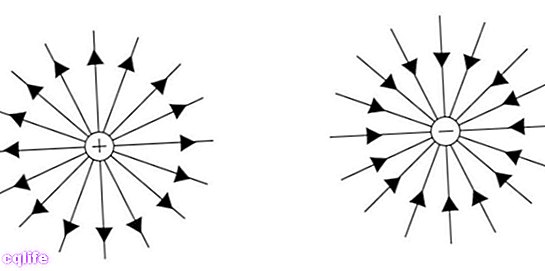- What is an electric field?
- History of the electric field
- Units of Electric Field
- Electric field formula
- Electric field intensity
- Electric field example
We explain what an electric field is, the history of its discovery, how its intensity is measured and what its formula is.

What is an electric field?
An electric field is a physical field or region of space that interacts with electric charges or bodies charged by an electric force. His representation by means of amodel describes the way in which different bodies and systems of an electrical nature interact with it.
Stated in physical terms, it is a vector field in which a electric charge A given (q) suffers the effects of an electric force (F).
These electric fields can be the consequence of the presence of electric charges, or of magnetic fields variables, as demonstrated by the experiments of British scientists Michel Faraday and James C. Maxwell.
For that reason, electric fields, in contemporary physical perspectives, are considered alongside magnetic fields to form electromagnetic fields.
Thus, an electric field is that region of space that has been modified by the presence of an electric charge. If this charge is positive, it generates electric field lines that "rise" in the charge and extend outward in a radial direction. If, on the other hand, the charge is negative, the field lines "die" on the charge. If a charge approaches the region of space where an electric field exists, it will experience an electric force with a address and meaning.
History of the electric field
The concept of electric field was proposed for the first time by Michel Faraday, arising from the need to explain the action of electric forces at a distance. This phenomenon was key in his demonstration of electromagnetic induction in 1831, thereby verifying the links between magnetism Yelectricity.
A later contribution to the electric field was that of James Maxwell, whose equations described multiple aspects of the electrical dynamics of these fields, especially in their Dynamic Electromagnetic Field Theory.
Units of Electric Field
Electric fields are not directly measurable, with any type of device. But it is possible to observe its effect on a load located in its vicinity, that is, it is possible to measure the force acting on the load (intensity). Newton / coulomb (N / C) are used for this.
Electric field formula
The equation that relates an electric field E with the force it exerts on a charge q is given by the following equation:
F = qE
Where F is the electric force that acts on the electric charge q introduced in the field with an intensity E. Note that both F and E are vector quantities, endowed with sense and direction.
From there, it is possible to advance mathematically by incorporating Coulomb's Law, obtaining that E = F / q = 1 / 4πϵ0 = (qi / r2) .ȓi, where ȓi are the unit vectors that mark the direction of the line that unite each charge qi with each charge q.
Electric field intensity

The intensity of the electric field is a vector quantity that represents the electric force F acting on a given charge in a precise amount of Newton / Coulomb (N / C).This magnitude is often called simply "electric field", because the field itself cannot be measured, but its effect on a given charge.
To calculate it, the formula F = q.E is used, taking into account that if the charge is positive (q> 0), the electric force will have the same sign as the field and q will move in the same direction; whereas if the charge is negative (q <0), everything will happen the other way around.
Electric field example
A simple example of calculating the intensity of an electric field is:
If we introduce an electric charge of 5 × 10-6 C into an electric field that acts with a force of 0.04 N, with what intensity does this field act?
Applying the formula E = F / q, we have that E = 0.04 N / 5 × 10-6 C = 8,000 N / C.
